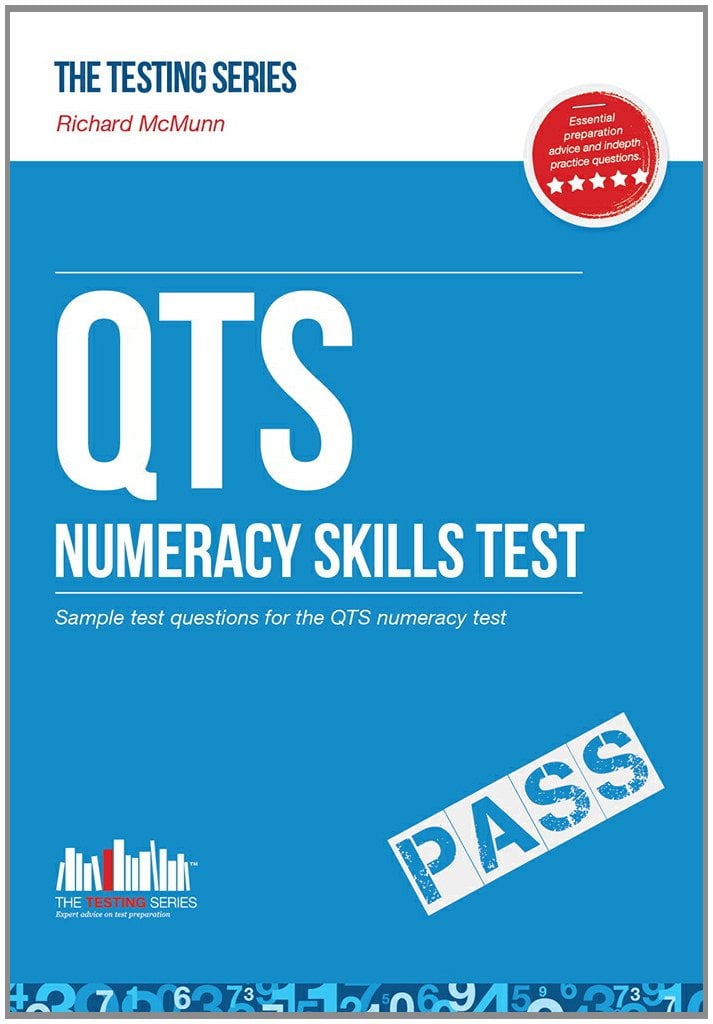 QTS numerical tests are a form of psychometric testing that measures a person’s ability and skill regarding mathematical data.
QTS numerical tests are a form of psychometric testing that measures a person’s ability and skill regarding mathematical data.
This blog works in connection with the How2become QTS guide, and we have provided you with detailed sample questions that will take you step-by-step through the process of working out each type of question.
The important thing to remember is to fully grasp the concept of each question. Once you have an understanding of how to apply the method to each question, you will then be able to use the same method to work out the other questions.
Within this guide, it will take you through the process of each question respective of how it is formatted in the QTS guide.
QTS NUMERACY TEST SECTION 1
Question
There are 21 pupils in a class. 3 pupils go for extra Numeracy lessons in a given lesson. What is the fraction of the pupils that remain in class? Give your answer in its lowest terms.
How to work it out
Step 1 = 3 people leave the class. The total of the class was 21, and so there will now be 18 pupils left in the class.
Step 2 = As a fraction of pupils that remain in the class, it would be written as 18/21.
Step 3 =(The number of students remaining in the class over the total number of pupils that was originally in the class).
Step 4 =18/21 in its simplest form = 6/7 (both numbers are divided by 3).
Answer
6/7.
QTS NUMERACY TEST SECTION 2
Question
2500 millilitres of liquid is divided into 20 containers. How many millilitres of liquid does each container have?
How to work it out
Step 1 = 2500 millilitres divided by 20 containers.
Step 2 = 2500 ÷20 = 125.
Answer
125.
QTS NUMERACY TEST SECTION 3
Question
A school trip in Belgium involves walking 24 Km every day. If 8km is approximately equal to 5 miles, estimate how many miles the daily walk consists of?
How to work it out
Step 1 = 8km = 5 miles.
Step 2 = They walk 24 km a day.
Step 3 = 24 divided by 8 = 3.
Step 4 =So 3 x 5 = 15 miles.
Answer
15 miles.
QTS NUMERACY TEST SECTION 4
Question
A team event consists of 16 tasks. Each task lasts 10 minutes. How many hours will this team event last in hours and minutes?
How to work it out
Step 1 = 16 tasks multiplied by 10 minutes = 160 minutes.
Step 2 = 160 minutes in hours and minutes = 2 hours and 40 minutes.
Answer
2 hours and 40 minutes.
QTS NUMERACY TEST SECTION 5
Question
A Maths lesson begins at 11:50. The teacher introduces the topic for 6 minutes, there is a warm up exercise for 18 minutes and finally work is done on the new topic for the last 26 minutes. When does the lesson end? Give your answer using the 24-hour clock?
How to work it out
Step 1 = Add up how many minutes each task takes.
Step 2 = 6 + 18 + 26 = 50 minutes.
Step 3 = So, if the lesson starts at 11. 50 and they are in the lesson for 50 minutes.
Step 4 = Their lesson will finish at 12.40.
Answer
12.40.
QTS NUMERACY TEST SECTION 6
Question
A school calculated that it had given merits to boys and girls in the ratio of 4:1.There were a total of 680 merits given. How many merits did the girls get?
How to work it out
Step 1 = There were 680 merits in total.
Step 2 = The ratio of boys to girls was 4:1.
Step 3 = 680 divided by 5 = 136 merits for the girls.
Answer
136.
QTS NUMERACY TEST SECTION 7
Question
In a Junior School there are 240 pupils and 35% have free school dinners. Work out the number of children who do not have free school dinners.
How to work it out
Step 1 = 35% have free school dinners. That means you want to work out the 65% that do not have free school dinners.
Step 2 = So 65% of 240 = 240 ÷ 100 x 65 = 156.
Answer
156.
QTS NUMERACY TEST SECTION 8
Question
220 pupils sat a GCSE Maths exam. The fraction of pupils who get Grade C or above is 3/5. How many pupils get Grade D or below?
How to work it out
Step 1 = 3/5 of pupils get a C grade or above. That means 2/5 of students received a D grade or below.
Step 2 = 220 pupil’s altogether. Divide it by the bottom number of the fraction (5).
Step 3 = 220 divided by 5 = 44 (that gives you 1/5).
Step 4 = 44 x 2 = 88 people received grade D or below.
Answer
88.
QTS NUMERACY TEST SECTION 9
Question
A pupil scores 45.5% in Test 1 and 64.5% in Test 2. What was the pupil’s average mark, assuming they were weighted equally?
How to work it out
Step 1 = To work out the average (or the mean) you add up the totals (45.5 + 64.5) and then divide it by how many totals there are (2).
Step 2 = 5 + 64.5 = 110 ÷ 2 = 55%.
Answer
55%.
QTS NUMERACY TEST SECTION 10
Question
There are 11 girls and 14 boys in a class. What is the percentage of girls in this class?
How to work it out
Step 1 = To work out the percentage of girls you add up the total of girls and boys (25).
Step 2 = 100 (%) divide it by 25 x 11 (multiply by 11 because that is the number of girls you are trying to work out).
Step 3 = 100 ÷ 25 x 11 = 44%.
Answer
44%.
QTS NUMERACY TEST SECTION 11
Question
A primary school has 80 pupils in year 3. 10 pupils have a reading age that is below their actual age. What is the percentage of pupils who have a reading age that is below their actual age? Give your answer to two decimal places.
How to work it out
Step 1 = 10 divided by 80 x 100 = 12.5%.
Answer
12.50%.
QTS NUMERACY TEST SECTION 12
Question
Two Geography classes get together to watch a video. The first class has 10 boys and 16 girls. The second class has 15 girls and 9 boys. When the class is combined what is the percentage of girls as a proportion of the total number of pupils?
How to work it out
Step 1 = Add up all boys and girls. 10 + 16 + 15 + 9 = 50.
Step 2 = Out of the 50 pupils, there are 16 + 15 girls = 31.
Step 3 = So 31 divided by 50 x 100 – 62% of the class are girls.
Answer
62%.
QTS NUMERACY TEST SECTION 13
Question
In a Science class 2/5 of the pupils achieved a level 5 in Key Stage 2. In another class ½ of the pupils achieve this level. What is the total fraction for both classes combined that achieves this level?
How to work it out
Step 1 = To add fractions that have different numbers on the bottom, you have to find a number that both numbers can go into.
Step 2 = 5 and 2 both can go into 10 (you want to find the smallest number that they both can go in).
Step 3 = In order to get 10 from 5, we multiplied it by 2, so you have to do the same to the top part of the fraction. 2 x 2 = 4. So the first fraction you have 4/10.
Step 4 = In order to get 10 from 2, we multiplied it by 5, so you have to do the same to the top part of the fraction. 5 x 1 = 5. So the second fraction gives you 5/10.
Step 5 = 4/10 + 5/10 = 9/10.
Answer
9/10.
QTS NUMERACY TEST SECTION 14
Question
A pupil scored 28%, 47% and 42% respectively in a three different maths tests. What was the pupil’s mean mark?
How to work it out
Step 1 = To work out the average (or the mean) you add up the totals (28 + 47 + 42) and then divide it by how many totals there are (3).
Step 2 = 28 + 47 + 42 = 117.
Step 3 = 117 ÷ 3 = 39%.
Answer
39%.
QTS NUMERACY TEST SECTION 15
Question
What is 12.5% of 380 Kilograms?
How to work it out
Step 1 = 12.5% of 380.
Step 2 = 380 ÷ 100 x 12.5 = 47.5.
Answer
47.5.
QTS NUMERACY TEST SECTION 16
Question
A school day ends at 3.30pm. In the afternoon there are only 2 sessions of 45 minutes with a 5 minute break in between. When does the afternoon session start?
How to work it out
Step 1 = Two sessions in the afternoon of 45 minutes each. 45 x 2 = 90.
Step 2 = 90 + 5 minute break = 95 minutes.
Step 3 = 95 minutes = 1 hour and 35 minutes.
Step 4 = 30pm – 1 hour and 35 minutes = 13.55pm.
Answer
13.55pm.
QTS NUMERACY TEST SECTION 17
Question
A History class joins a Science class for a school trip. The total number of pupils in this trip is 49. If 3/7 of the pupils were from the Science class, how many pupils were there from the History class?
How to work it out
Step 1 = If 3/7 of the pupils were from the science class, which means 4/7 are from the history class.
Step 2 = So, 49 pupils in total divided by 7 = 7 x 4 = 28 pupils are from the history class.
Answer
28.
QTS NUMERACY TEST SECTION 18
Question
A coach can accommodate 54 people. There are 36 pupils who go on a school outing in this coach. During the outing there has to be one teacher for every 6 pupils. How many vacant seats are there?
How to work it out
Step 1 = There are 36 pupils attending the trip.
Step 2 = For every 6 pupils there has to be one teacher.
Step 3 = 36 divided by 6 = 6 teachers.
Step 4 = 36 pupils + 6 teachers + 42 people.
Step 5 = There is 54 seats. So, the number of vacant seats is 54 – 42 = 12.
Answer
12.
QTS NUMERACY TEST SECTION 19
Question
A teacher needs to write reports in her subject for 32 pupils. Each report will takes her an average of 9 minutes to write. She also spends an average of 4 minutes checking each report. How long in hours and minutes does it take the teacher to finish the entire report writing tasks?
How to work it out
Step 1 = In total it takes 13 minutes to look at one report.
Step 2 = The teacher has 32 reports to write.
Step 3 = 32 reports x 13 minutes (each) = 416 minutes.
Step 4 = 416 minutes = 6 hours and 56 minutes.
Answer
6 hours and 56 minutes.
QTS NUMERACY TEST SECTION 20
Question
What is 454 divided by 0.2?
How to work it out
Step 1 = If you were dividing by 0.1, you would simply add a 0.
Step 2 = To get 0.2, you would half the answer you got for 0.1
Step 3 = 4540 divided by 2 = 2270.
Answer
2270.
QTS NUMERACY TEST SECTION 21
Question
The lowest score on a Maths test is 53. The highest score is 92. The median score is 71. The lower quartile is 56 and the upper quartile is 87. Represent this information with a box-and-whisker plot.
How to work it out
Step 1 = The lowest score forms the first line. The highest score forms the last line. The median score is the line in the middle of the box. The lower interquartile is the lower section of the box and the upper quartile forms the upper part of the box. (please see diagram above).
Answer
Your answer should look something like this:

QTS NUMERACY TEST SECTION 22
Question
Test marks in Maths, History and English for Year 9 are compared by three box – and – whisker diagrams shown below. Marks are shown on the vertical axis.
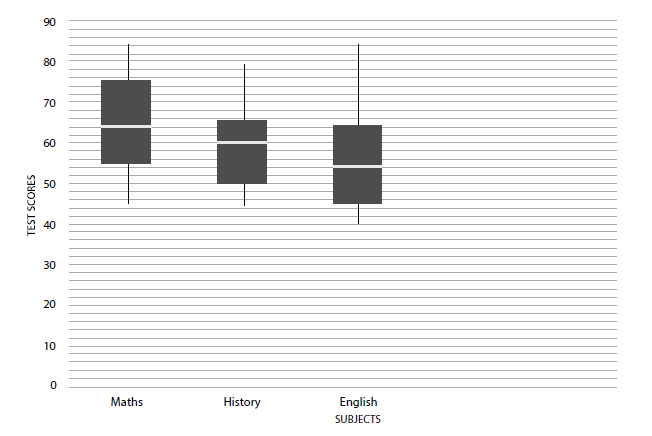
Question 1 = The interquartile range for Maths is higher than that for English. True or false?
Question 2 = The lowest mark was in History. True or false?
Question 3 = The median score for Maths is 65. True or false?
Answers
1. True (work out the difference between the lower and higher quartiles).
2. False = (lowest mark was in English).
3. False (The median score was 64).
QTS NUMERACY TEST SECTION 23
Question
The set of data below shows the result in a year 9 History test for 50 pupils. The marks are out of 10. The teacher wants to find the mean mark for this test. Give your answer to 1 decimal place.
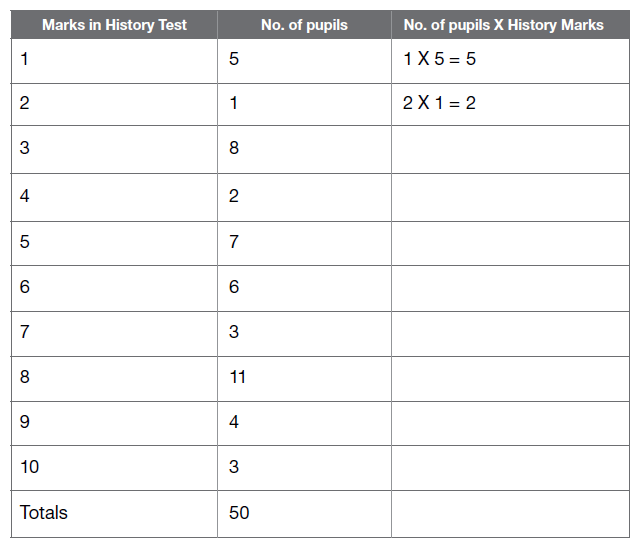
How to work it out
Step 1 = In order to work this out, you have to fill in the last column, like shown in the previous two boxes.
Step 2 = You then add up the answers in the last column.
Step 3 = Divide that by the number of pupils and then multiply by 100. (No.of pupils / total of last column x by 100).
Step 4 = 5.7 is the average mark.
Answer
5.7.
QTS NUMERACY TEST SECTION 24
Question
A Mock exam in Science consists of two papers. The first paper is out of 50 and has weighting of 75% given to it. The second paper is out of 40 and has a weighting of 25% given to it. A pupil gets 44 in the first paper and 27 in the second paper. What is the pupil’s final percentage score? Give your answer to 1 decimal place.
How to work it out
Step 1 = First paper = 44 (marks) divide it by 50 (total of marks) multiply it by 75% (percentage weight) – 66.
Step 2 = Second paper = 27 ÷ 40 x 25 = 16.875.
Step 3 = 66 + 16.875 = 82.875.
Step 4 = To one decimal place = 82.9%.
Answer
82.9%.
QTS NUMERACY TEST SECTION 25
Question
The two way table shown compares pupils’ results for GCSE Maths with GCSE Science grades.
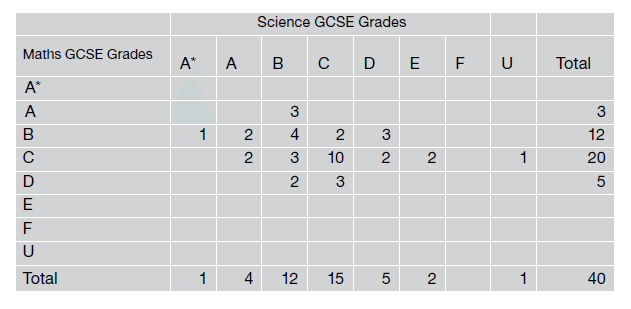
Question 1 = The number of pupils who achieved a C grade in both Science and Maths is 3. True or false?
Question 2 = The number of pupils who got a B grade in Maths is 12. True or false?
Question 3 = The percentage of pupils who received a C grade in Science is approximately 37.5%. True or false?
Answers
1. False (number of pupils would be 10).
2. True.
3. True.
QTS NUMERACY TEST SECTION 26
Question
The pie chart below shows the number of pupils who got a Grade C or better in Science in three different schools.
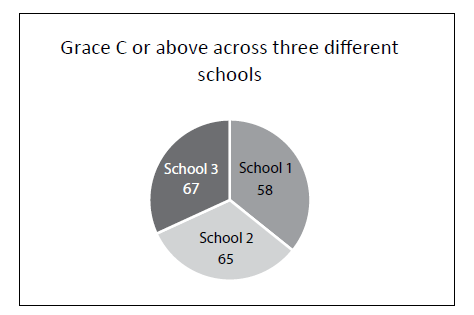
Question 1 = The percentage of pupils who got a grade C or above in Science in School 1 compared to all the schools combined was approximately 30.5%. True or false?
Question 2 = The total percentage success at Grade C or above in Science at School 1 and School 2 combined compared to all schools was approximately 64.7%. True or false?
Question 3 = The proportion of pupils getting a grade C or above in Science at School 3 compared to all schools was 67/190. True or false?
Answers
1. True (58 ÷ 190 x 100).
2. True (58+65 ÷ 190 x 100).
3. True.
QTS NUMERACY TEST SECTION 27
Question
Pupils who succeeded in getting Maths GCSE at Grade C or above were analysed from 2006 to 2012.
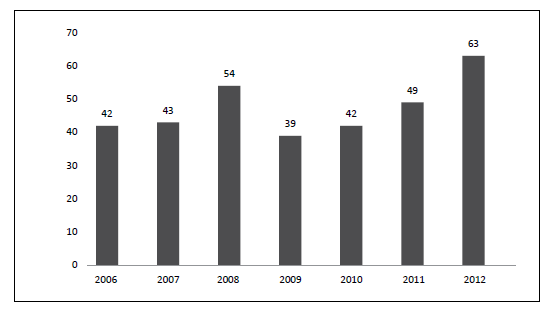
Question 1 = The percentage of GCSE at grades C or above increased every year. True or false?
Question 2 = The mean percentage from 2009 to 2012 was 48.25%. True or false?
Question 3 = The difference from the lowest percentage of pupils received a Maths GCSE at C grade or above to the highest is 24. True or false?
Answers
1. False (it decreases in year 2009).
2. True (29+42+49+63) ÷ 4).
3. True (lowest was 39, highest was 63, so the difference is 24).
QTS NUMERACY TEST SECTION 28
Question
The head of English created the following table showing the number of pupils in each year group who had additional help in English. What is the percentage of pupils in all the year groups combined that are having additional tuition. Give your answer rounded to a whole number.

How to work it out
Step 1 = Add up total number of pupils.
Step 2 = Add up no. of pupils receiving addition English help.
Step 3 = 76 ÷ 529 = 14% (as a whole number).
Answer
14%.
QTS NUMERACY TEST SECTION 29
Question
Maths GCSE grades were recorded for 40 pupils. The data is shown on a cumulative frequency diagram below. Indicate all true statements below:
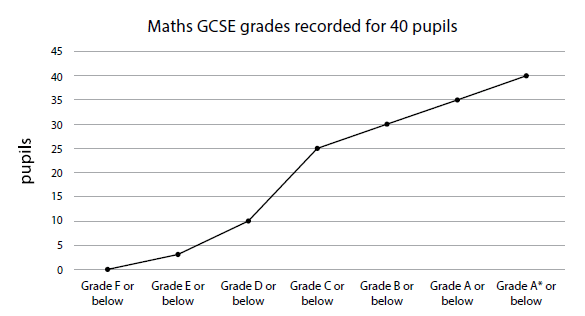
Question 1 = 15 pupils get above Grade C. True or false?
Question 2 = 30 pupils get above Grade D. True or false? True (the dot on the line D grade or below is on 10. There are 40 pupils. 40 – 10 = 30).
Question 3 = 50% of the 40 pupils get a C Grade or above. True or false? False (only 15 people get a C grade or above. There are 40 pupils, therefore is not 50%).
Answers
1. True (the dot on the line C grade or below is on 25. There are 40 pupils. 40 – 25 = 15).
2. True (the dot on the line D grade or below is on 10. There are 40 pupils. 40 – 10= 30).
3. False (only 15 people get a C grade or above. There are 40 pupils, therefore is not 50%).
QTS NUMERACY TEST SECTION 30
Question
A teacher represents the relationship between marks in a maths test and an English test by the scatter graph shown below. The Maths marks are out of 50 and the English marks are out of 20. Indicate all true statements below:
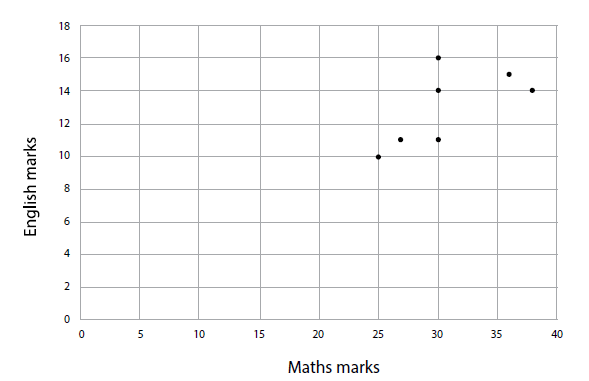
Question 1 = The correlation between Maths and English marks in this test was negative. True or false?
Question 2 = When the pupils mark in Maths was 25, there mark in English was 10. True or false?
Question 3 = The mean mark in the Maths test was approximately 31. True or false?
Answers
1. False (it’s positive not negative, as the English marks increase, the maths marks increase).
2. True.
3. True (25+27+30+30+30+36+38 = 216 ÷ 7 = 30.8, rounded up 31).
The answer to question one is wrong.
Good spot – thanks. We have updated the post 🙂
On question 23 you said the answer is 5.7, but if you follow the method you give: add the column up then divide by number of children then multiply by 100 (285/50 x 100) you get 570 not 5.7?
Hello Amy,
Thank you for your message.
Because the pupil’s mark are out of 57, the average mark would have to be between 0 and 10. Therefore the answer would be an average of 5.7
hi,
on Q 21 you have it all good but on the lower quartile you say its 51 yet the axes shows on 56..???
a bit confusing .
Hi Julia, thanks for your comment.
Thanks for bringing this mistake to our attention. We have now updated it so that it makes sense.
Kind regards,
The How2Become Team.
Thanks for such tutorials.
Hi Konkuri,
You are most welcome. Be sure to check out our website in future, for further great tips!
Sincerely,
The How2Become Team
Usuyally I don’t read post on blogs, however I would like to say tjat this
write-up very forced me to check out and do it! Your writig style has
been surprised me. Thanks, very great post.
Hi there,
We’re glad you found this useful!
Sincerely,
The How2Become Team
Good but trickish
Hi Millicent,
We’re glad you found this useful! It’s meant to be tricky ;).
Be sure to check out our QTS Numeracy book
Sincerely,
The How2Become Team
Can I get some of the book to buy in Ghana and which book shop will I get it
Hi Millicent,
We don’t distribute directly to Ghana, however you should be able to find the book on Amazon =].
Sincerely,
The How2Become Team
excellent questions ….
Hi, thanks for the comment. We hope you found the questions and answers useful!
Kind regards,
The How2Become Team.
Very helpful indeed. Thanks.
Hi Mahamoud,
We’re really glad to hear you found this useful!
Sincerely,
The How2Become Team
id like the full worksheet pls
Hi Priya,
It’s great to hear that you are interested in our guide. You can download more questions and answers with our fantastic QTS Numerical Skills Tests book
Hope this helps!
Sincerely,
The How2Become Team
useful
In Question 11, the question asks for the “percentage” yet your answer is specified as a decimal (0.125). As 10/80 or 1/8 is 12.5%, 12.50% would be the answer, depending on your request for 2 decimal places.
Hi James,
Thanks for your comment. We’ve updated the page now to reflect this.
Thanks,
The How2Become Team
Thanks
Excellent!
Excellent, thank you
No problem, we’re so glad we could help!
Sincerely,
The How2Become Team
This is very helpful. Please can I have the worksheet emailed to me, please? Thank you.
Hi HJM,
Please email our main inbox, [email protected] with your contact details, and we’ll get in touch with the worksheet =].
Sincerely,
The How2Become Team
This is very helpful because i use this for my studies and my tests